check engine Citroen DS3 2011 1.G Owner's Manual
[x] Cancel search | Manufacturer: CITROEN, Model Year: 2011, Model line: DS3, Model: Citroen DS3 2011 1.GPages: 324, PDF Size: 25.11 MB
Page 7 of 324
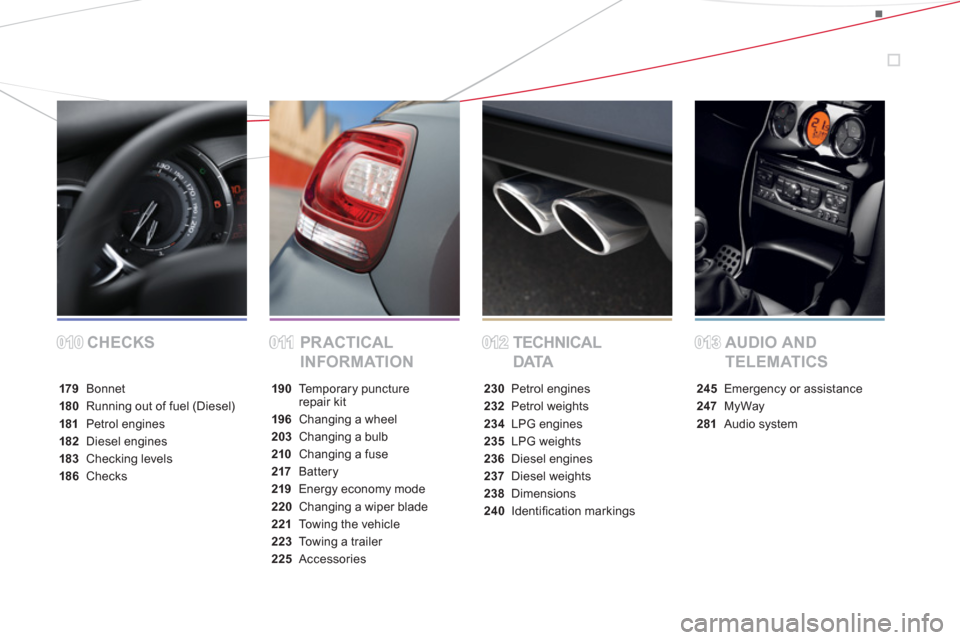
CHECKS PRACTICAL
INFORMATIONTECHNICAL
DATAAUDIO AND
TELEMATICS
179 Bonnet
180 Running out of fuel (Diesel)
181 Petrol engines
182 Diesel engines
183 Checking levels
186 Checks190 Temporary puncture
repair kit
196 Changing a wheel
203 Changing a bulb
210 Changing a fuse
217 Battery
219 Energy economy mode
220 Changing a wiper blade
221 Towing the vehicle
223 Towing a trailer
225 Accessories230 Petrol engines
232 Petrol weights
234 LPG engines
235 LPG weights
236 Diesel engines
237 Diesel weights
238 Dimensions
240 Identifi cation markings245 Emergency or assistance
247 MyWay
281 Audio system
012012013013010010011011
Page 25 of 324
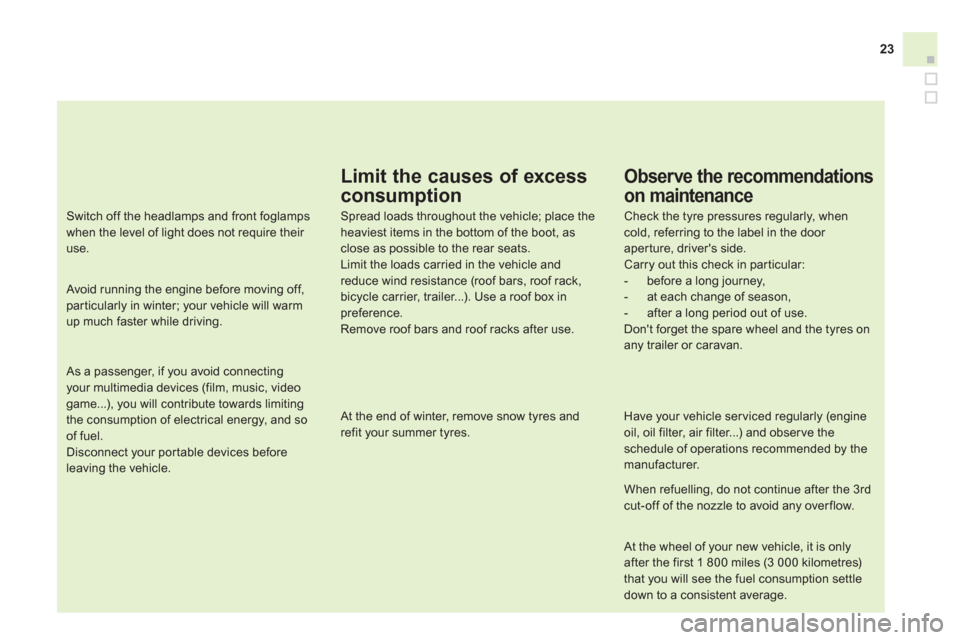
23
Limit the causes of excess
consumption
Spread loads throughout the vehicle; place the
heaviest items in the bottom of the boot, as
close as possible to the rear seats.
Limit the loads carried in the vehicle and
reduce wind resistance (roof bars, roof rack,
bicycle carrier, trailer...). Use a roof box in
preference.
Remove roof bars and roof racks after use.
At the end of winter, remove snow tyres and
refit your summer tyres.
Observe the recommendations
on maintenance
Check the tyre pressures regularly, when
cold, referring to the label in the door
aperture, driver's side.
Carry out this check in par ticular:
- before a long journey,
- at each change of season,
- after a long period out of use.
Don't forget the spare wheel and the tyres on
any trailer or caravan.
Have your vehicle ser viced regularly (engine
oil, oil filter, air filter...) and obser ve the
schedule of operations recommended by the
manufacturer.
When refuelling, do not continue after the 3 rd
cut-off of the nozzle to avoid any over flow.
At the wheel of your new vehicle, it is only
after the first 1 800 miles (3 000 kilometres)
that you will see the fuel consumption settle
down to a consistent average.
Switch off the headlamps and front foglamps
when the level of light does not require their
use.
Avoid running the engine before moving off,
particularly in winter; your vehicle will warm
up much faster while driving.
As a passenger, if you avoid connecting
your multimedia devices (film, music, video
game...), you will contribute towards limiting
the consumption of electrical energy, and so
of fuel.
Disconnect your portable devices before
leaving the vehicle.
Page 37 of 324
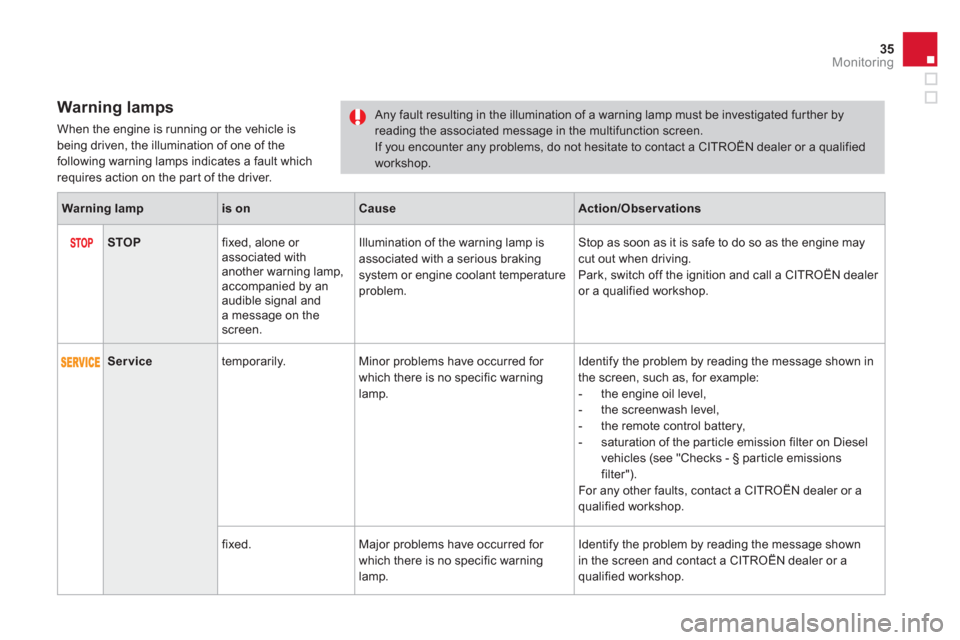
35Monitoring
Warning lamps
When the engine is running or the vehicle is
being driven, the illumination of one of the
following warning lamps indicates a fault which
requires action on the par t of the driver. Any fault resulting in the illumination of a warning lamp must be investigated fur ther by
reading the associated message in the multifunction screen.
If you encounter any problems, do not hesitate to contact a CITROËN dealer or a qualified
workshop.
Warning lamp
is on
Cause
Action/Observations
STOP
fixed, alone or
associated with
another warning lamp,
accompanied by an
audible signal and
a message on the
screen. Illumination of the warning lamp is
associated with a serious braking
system or engine coolant temperature
problem. Stop as soon as it is safe to do so as the engine may
cut out when driving.
Park, switch off the ignition and call a CITROËN dealer
or a qualified workshop.
Service
temporarily. Minor problems have occurred for
which there is no specific warning
lamp. Identify the problem by reading the message shown in
the screen, such as, for example:
- the engine oil level,
- the screenwash level,
- the remote control battery,
- saturation of the par ticle emission filter on Diesel
vehicles (see "Checks - § par ticle emissions
filter").
For any other faults, contact a CITROËN dealer or a
qualified workshop.
fixed. Major problems have occurred for
which there is no specific warning
lamp. Identify the problem by reading the message shown
in the screen and contact a CITROËN dealer or a
qualified workshop.
Page 39 of 324
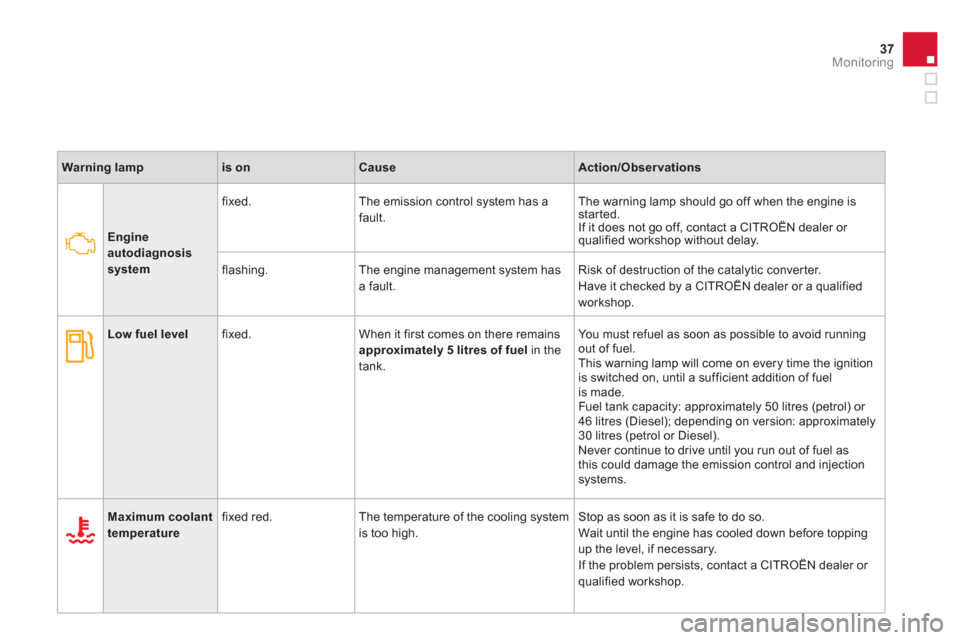
37Monitoring
Warning lamp
is on
Cause
Action/Observations
Engine
autodiagnosis
system
fixed. The emission control system has a
fault. The warning lamp should go off when the engine is
started.
If it does not go off, contact a CITROËN dealer or
qualified workshop without delay.
flashing. The engine management system has
a fault. Risk of destruction of the catalytic conver ter.
Have it checked by a CITROËN dealer or a qualified
workshop.
Low fuel level
fixed. When it first comes on there remains
approximately 5 litres of
fuel
in the
tank. You must refuel as soon as possible to avoid running
out of fuel.
This warning lamp will come on every time the ignition
is switched on, until a sufficient addition of fuel
is made.
Fuel tank capacity: approximately 50 litres (petrol) or
46 litres (Diesel); depending on version: approximately
30 litres (petrol or Diesel).
Never continue to drive until you run out of fuel as
this could damage the emission control and injection
systems.
Maximum coolant
temperature
fixed red. The temperature of the cooling system
is too high. Stop as soon as it is safe to do so.
Wait until the engine has cooled down before topping
up the level, if necessary.
If the problem persists, contact a CITROËN dealer or
qualified workshop.
Page 41 of 324
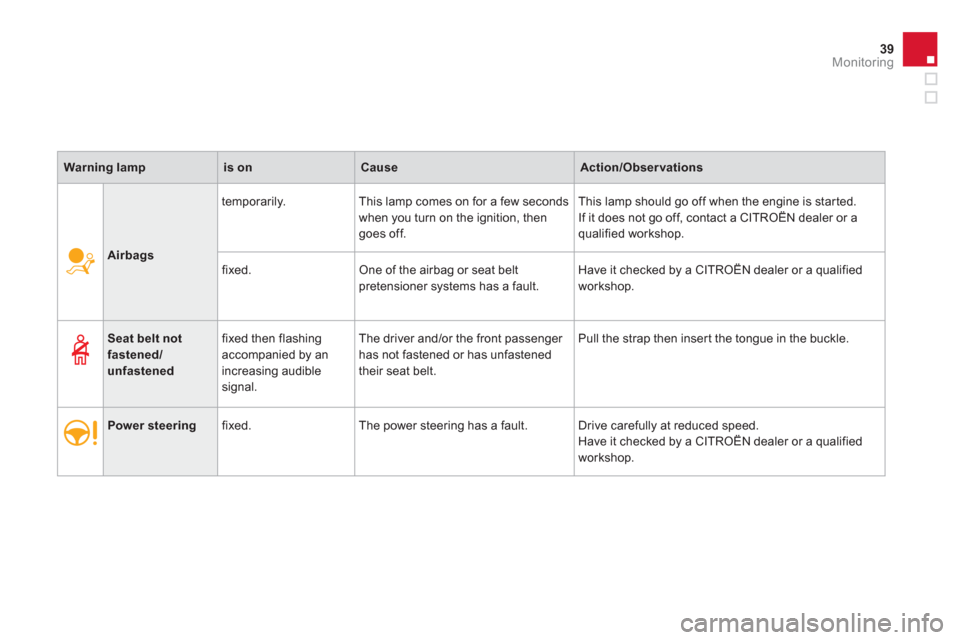
39Monitoring
Airbags
temporarily. This lamp comes on for a few seconds
when you turn on the ignition, then
goes off. This lamp should go off when the engine is star ted.
If it does not go off, contact a CITROËN dealer or a
qualified workshop.
fixed. One of the airbag or seat belt
pretensioner systems has a fault. Have it checked by a CITROËN dealer or a qualified
workshop.
Warning lamp
is on
Cause
Action/Observations
Seat belt not
fastened/
unfastened
fixed then flashing
accompanied by an
increasing audible
signal. The driver and/or the front passenger
has not fastened or has unfastened
their seat belt. Pull the strap then inser t the tongue in the buckle.
Power steering
fixed. The power steering has a fault. Drive carefully at reduced speed.
Have it checked by a CITROËN dealer or a qualified
workshop.
Page 45 of 324
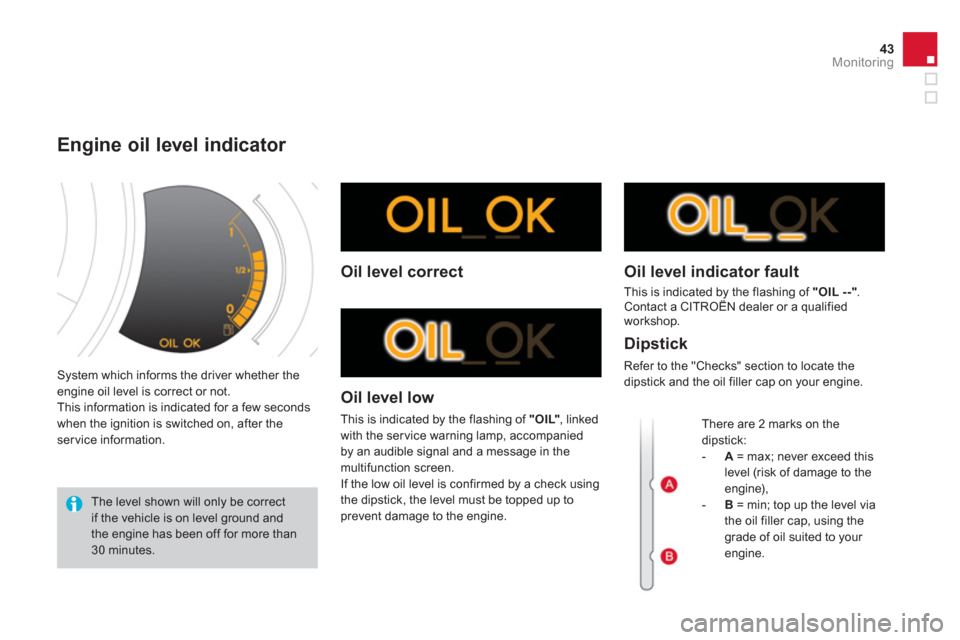
43Monitoring
System which informs the driver whether the
engine oil level is correct or not.
This information is indicated for a few seconds
when the ignition is switched on, after the
service information.
Engine oil level indicator
The level shown will only be correct
if the vehicle is on level ground and
the engine has been off for more than
30 minutes.
Oil level correct
Oil level low
This is indicated by the flashing of "OIL"
, linked
with the ser vice warning lamp, accompanied
by an audible signal and a message in the
multifunction screen.
If the low oil level is confirmed by a check using
the dipstick, the level must be topped up to
prevent damage to the engine.
Oil level indicator fault
This is indicated by the flashing of "OIL --"
.
Contact a CITROËN dealer or a qualified
workshop.
There are 2 marks on the
dipstick:
- A
= max; never exceed this
level (risk of damage to the
engine),
- B
= min; top up the level via
the oil filler cap, using the
grade of oil suited to your
engine.
Dipstick
Refer to the "Checks" section to locate the
dipstick and the oil filler cap on your engine.
Page 67 of 324
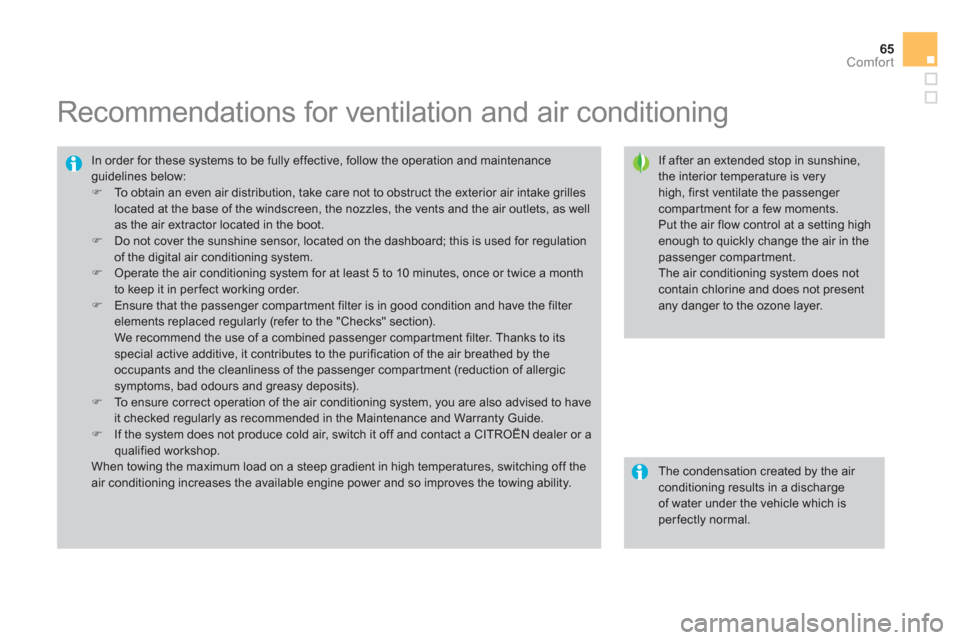
65Comfort
Recommendations for ventilation and air conditioning
If after an extended stop in sunshine,
the interior temperature is very
high, first ventilate the passenger
compartment for a few moments.
Put the air flow control at a setting high
enough to quickly change the air in the
passenger compartment.
The air conditioning system does not
contain chlorine and does not present
any danger to the ozone layer. In order for these systems to be fully effective, follow the operation and maintenance
guidelines below:
�)
To obtain an even air distribution, take care not to obstruct the exterior air intake grilles
located at the base of the windscreen, the nozzles, the vents and the air outlets, as well
as the air extractor located in the boot.
�)
Do not cover the sunshine sensor, located on the dashboard; this is used for regulation
of the digital air conditioning system.
�)
Operate the air conditioning system for at least 5 to 10 minutes, once or twice a month
to keep it in per fect working order.
�)
Ensure that the passenger compartment filter is in good condition and have the filter
elements replaced regularly (refer to the "Checks" section).
We recommend the use of a combined passenger compartment filter. Thanks to its
special active additive, it contributes to the purification of the air breathed by the
occupants and the cleanliness of the passenger compartment (reduction of allergic
symptoms, bad odours and greasy deposits).
�)
To ensure correct operation of the air conditioning system, you are also advised to have
it checked regularly as recommended in the Maintenance and Warranty Guide.
�)
If the system does not produce cold air, switch it off and contact a CITROËN dealer or a
qualified workshop.
When towing the maximum load on a steep gradient in high temperatures, switching off the
air conditioning increases the available engine power and so improves the towing ability.
The condensation created by the air
conditioning results in a discharge
of water under the vehicle which is
per fectly normal.
Page 81 of 324
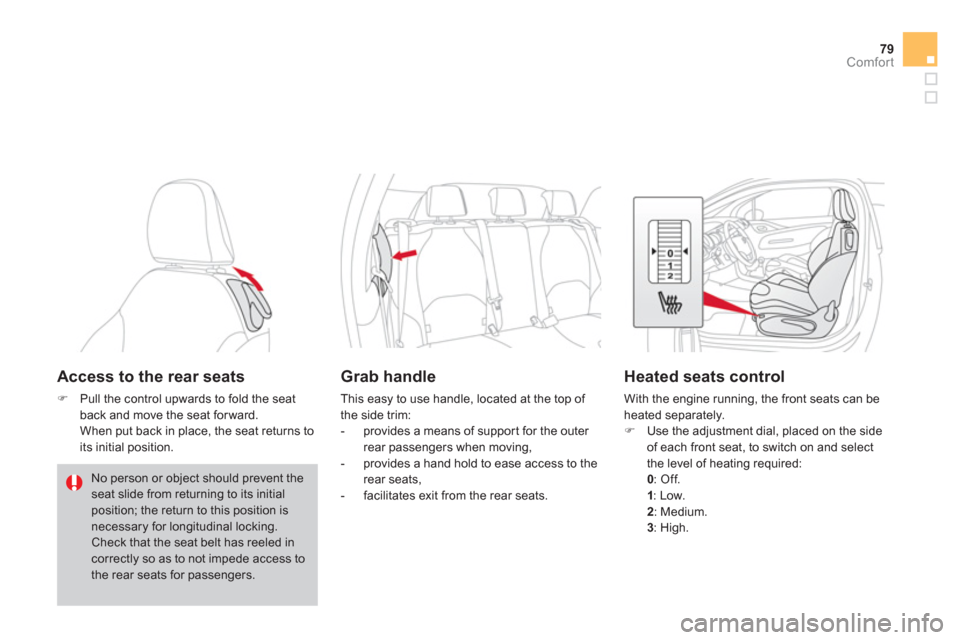
79Comfort
Access to the rear seats
�)
Pull the control upwards to fold the seat
back and move the seat for ward.
When put back in place, the seat returns to
its initial position.
No person or object should prevent the
seat slide from returning to its initial
position; the return to this position is
necessary for longitudinal locking.
Check that the seat belt has reeled in
correctly so as to not impede access to
the rear seats for passengers.
Heated seats control
With the engine running, the front seats can be
heated separately.
�)
Use the adjustment dial, placed on the side
of each front seat, to switch on and select
the level of heating required:
0: Off.
1
: Low.
2
: Medium.
3
: High.
Grab handle
This easy to use handle, located at the top of
the side trim:
- provides a means of suppor t for the outer
rear passengers when moving,
- provides a hand hold to ease access to the
rear seats,
- facilitates exit from the rear seats.
Page 102 of 324
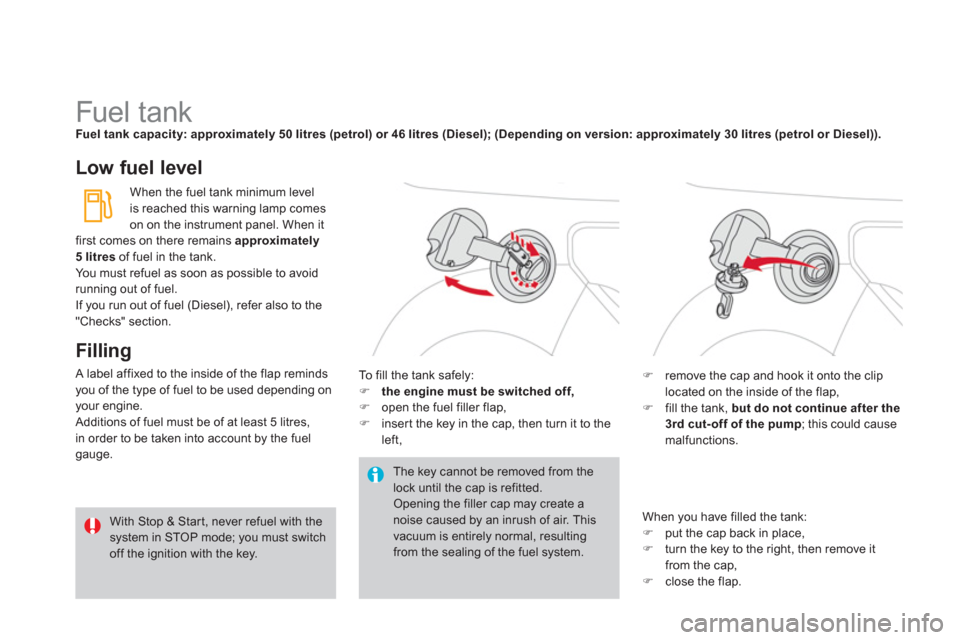
Fuel tank
Fuel tank capacity: approximately 50 litres (petrol) or 46 litres (Diesel); (Depending on version: approximately 30 litres (petrol or Diesel)).
Low fuel level
Filling
A label affixed to the inside of the flap reminds
you of the type of fuel to be used depending on
your engine.
Additions of fuel must be of at least 5 litres,
in order to be taken into account by the fuel
gauge.
The key cannot be removed from the
lock until the cap is refitted.
Opening the filler cap may create a
noise caused by an inrush of air. This
vacuum is entirely normal, resulting
from the sealing of the fuel system. To fill the tank safely:
�)
the engine must be switched off,
�)
open the fuel filler flap,
�)
inser t the key in the cap, then turn it to the
left,
�)
remove the cap and hook it onto the clip
located on the inside of the flap,
�)
fill the tank, but do not continue after the
3rd cut- off of the pump
; this could cause
malfunctions.
When you have filled the tank:
�)
put the cap back in place,
�)
turn the key to the right, then remove it
from the cap,
�)
close the flap.
When the fuel tank minimum level
is reached this warning lamp comes
on on the instrument panel. When it
first comes on there remains approximately
5 litres
of fuel in the tank.
You must refuel as soon as possible to avoid
running out of fuel.
If you run out of fuel (Diesel), refer also to the
"Checks" section.
With Stop & Star t, never refuel with the
system in STOP mode; you must switch
off the ignition with the key.
Page 104 of 324
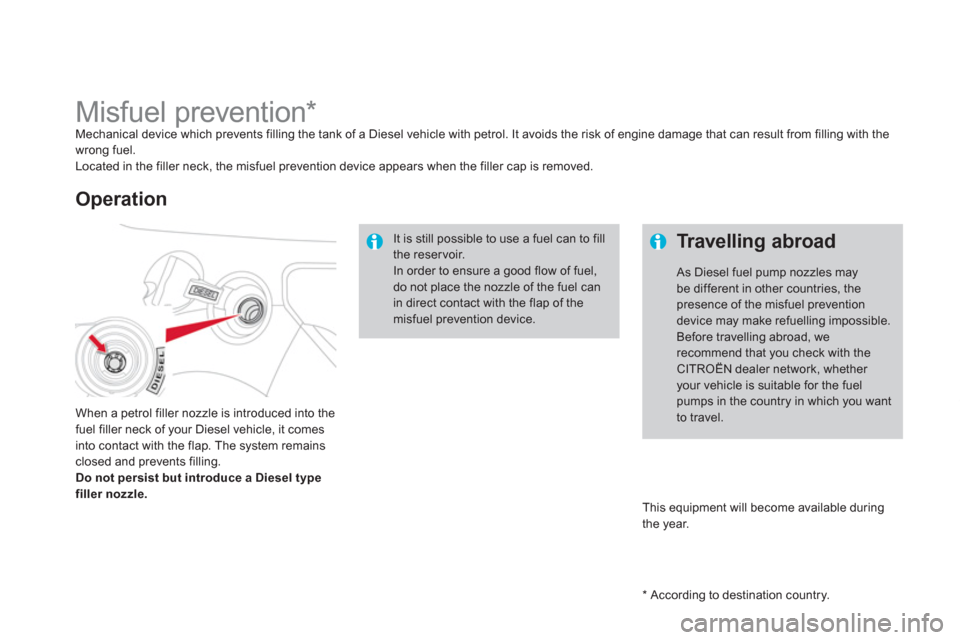
*
According to destination country.
Misfuel prevention *
Mechanical device which prevents filling the tank of a Diesel vehicle with petrol. It avoids the risk of engine damage that can result from filling with the
wrong fuel.
Located in the filler neck, the misfuel prevention device appears when the filler cap is removed.
Operation
When a petrol filler nozzle is introduced into the
fuel filler neck of your Diesel vehicle, it comes
into contact with the flap. The system remains
closed and prevents filling.
Do not persist but introduce a Diesel type
filler nozzle.
It is still possible to use a fuel can to fill
the reser voir.
In order to ensure a good flow of fuel,
do not place the nozzle of the fuel can
in direct contact with the flap of the
misfuel prevention device.
This equipment will become available during
the year.
Tr a v e l l i n g a b r o a d
As Diesel fuel pump nozzles may
be different in other countries, the
presence of the misfuel prevention
device may make refuelling impossible.
Before travelling abroad, we
recommend that you check with the
CITROËN dealer network, whether
your vehicle is suitable for the fuel
pumps in the country in which you want
to travel.